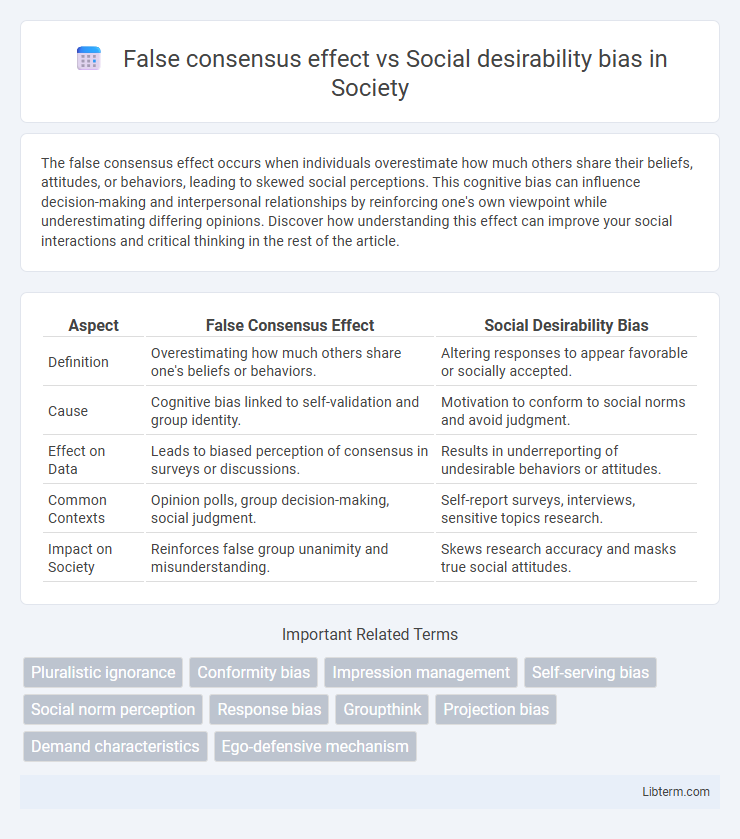The false consensus effect occurs when individuals overestimate how much others share their beliefs, attitudes, or behaviors, leading to skewed social perceptions. This cognitive bias can influence decision-making and interpersonal relationships by reinforcing one's own viewpoint while underestimating differing opinions. Discover how understanding this effect can improve your social interactions and critical thinking in the rest of the article.
Table of Comparison
| Aspect | False Consensus Effect | Social Desirability Bias |
|---|---|---|
| Definition | Overestimating how much others share one's beliefs or behaviors. | Altering responses to appear favorable or socially accepted. |
| Cause | Cognitive bias linked to self-validation and group identity. | Motivation to conform to social norms and avoid judgment. |
| Effect on Data | Leads to biased perception of consensus in surveys or discussions. | Results in underreporting of undesirable behaviors or attitudes. |
| Common Contexts | Opinion polls, group decision-making, social judgment. | Self-report surveys, interviews, sensitive topics research. |
| Impact on Society | Reinforces false group unanimity and misunderstanding. | Skews research accuracy and masks true social attitudes. |
Introduction to Cognitive Biases in Social Perception
False consensus effect leads individuals to overestimate how much others share their beliefs, creating a distorted social perception and reinforcing personal viewpoints. Social desirability bias causes people to present themselves in a favorable light, often misrepresenting true attitudes to conform to societal norms. Both biases influence cognitive processing in social contexts, affecting the accuracy of interpersonal judgments and decision-making.
Defining the False Consensus Effect
The False Consensus Effect refers to the cognitive bias where individuals overestimate the extent to which their beliefs, opinions, or behaviors are normal and widely shared by others. This bias leads people to assume a consensus that often does not exist, influencing social judgments and decision-making. Unlike Social Desirability Bias, which involves altering responses to conform to perceived social norms, the False Consensus Effect stems from an internal conviction about the commonality of one's views.
Understanding Social Desirability Bias
Social desirability bias occurs when individuals alter their responses to align with socially accepted norms, often leading to inaccurate self-reporting in surveys or research. This bias complicates data collection by masking true attitudes or behaviors as participants seek approval or to avoid judgment. Understanding social desirability bias is crucial for developing more reliable measurement techniques, such as anonymous surveys or indirect questioning, to capture genuine responses.
Key Differences Between False Consensus Effect and Social Desirability Bias
The false consensus effect occurs when individuals overestimate how much others share their beliefs, attitudes, or behaviors, leading to biased perceptions of social norms. Social desirability bias involves individuals altering their responses to conform to perceived social expectations or to present themselves favorably. The key difference lies in false consensus bias being a cognitive bias about others' agreement, whereas social desirability bias reflects intentional modification of self-presentation to match idealized standards.
Psychological Mechanisms Behind Each Bias
The false consensus effect arises from an individual's tendency to overestimate how much others share their beliefs, attitudes, or behaviors, driven by selective exposure to similar people and the need for social validation. Social desirability bias stems from the motivation to present oneself favorably to conform to social norms, involving self-censorship and impression management. Both biases engage cognitive and motivational processes but differ as the false consensus effect involves projection of personal views, while social desirability bias results from regulatory efforts to align with perceived social expectations.
Real-life Examples of False Consensus Effect
The false consensus effect occurs when individuals overestimate how much others share their beliefs or behaviors, such as a person who smokes assuming the majority of their peers also smoke. This cognitive bias contrasts with social desirability bias, where individuals modify their responses to appear favorable, like understating unhealthy habits in surveys. Real-life examples include voters believing their political views are more widely accepted than they are or employees assuming everyone supports a workplace policy, which can lead to misjudgments in social and professional settings.
Real-life Examples of Social Desirability Bias
Social desirability bias frequently appears in survey responses where participants overreport positive behaviors such as voting or exercising, skewing data accuracy. In healthcare, patients may underreport unhealthy habits like smoking due to fear of judgment, complicating diagnosis and treatment. Workplace evaluations also show this bias as employees provide overly favorable self-assessments to enhance their professional image.
Impact on Research and Survey Results
The false consensus effect causes participants to overestimate how much others share their beliefs, leading to biased survey results by inflating perceived consensus and skewing data interpretation. Social desirability bias prompts respondents to answer questions in a manner that will be viewed favorably by others, resulting in underreporting of undesirable behaviors and overreporting of positive traits, which distorts the accuracy of self-reported data. Both biases compromise research validity by introducing systematic errors that affect data reliability and lead to erroneous conclusions in behavioral and social science studies.
Strategies to Minimize Both Biases
Implementing anonymous surveys helps reduce social desirability bias by allowing respondents to answer more honestly without fear of judgment. Encouraging diverse viewpoints and emphasizing that differing opinions are normal can minimize the false consensus effect by preventing individuals from overestimating agreement. Using indirect questioning techniques and ensuring confidentiality further decreases both biases by promoting truthful responses and reducing pressure to conform.
Conclusion: Navigating Social Perception Biases
False consensus effect leads individuals to overestimate how much others share their beliefs, creating distorted social perceptions, while social desirability bias causes people to misreport opinions to align with perceived societal norms. Recognizing these biases is crucial for accurate interpretation of social data and effective communication. Managing awareness of both effects helps individuals and researchers minimize errors in judgment and promotes more authentic social interactions.
False consensus effect Infographic

 libterm.com
libterm.com